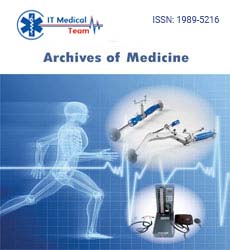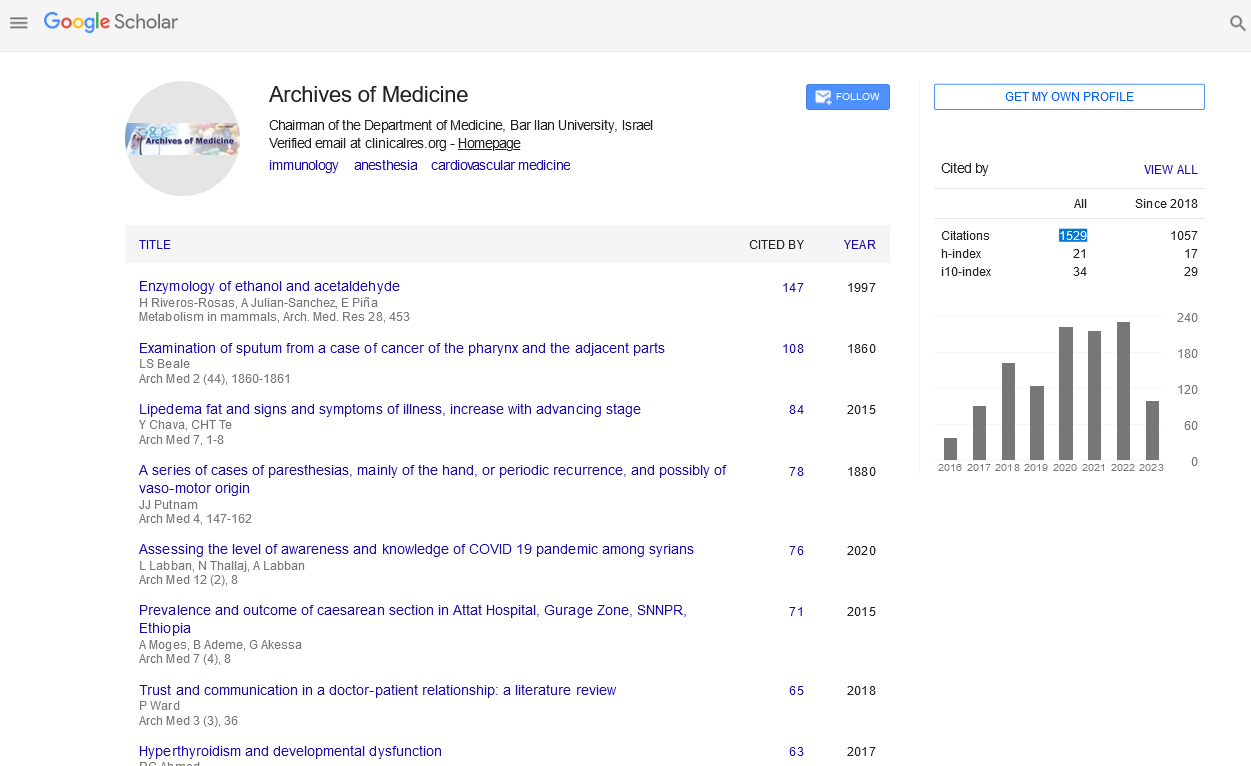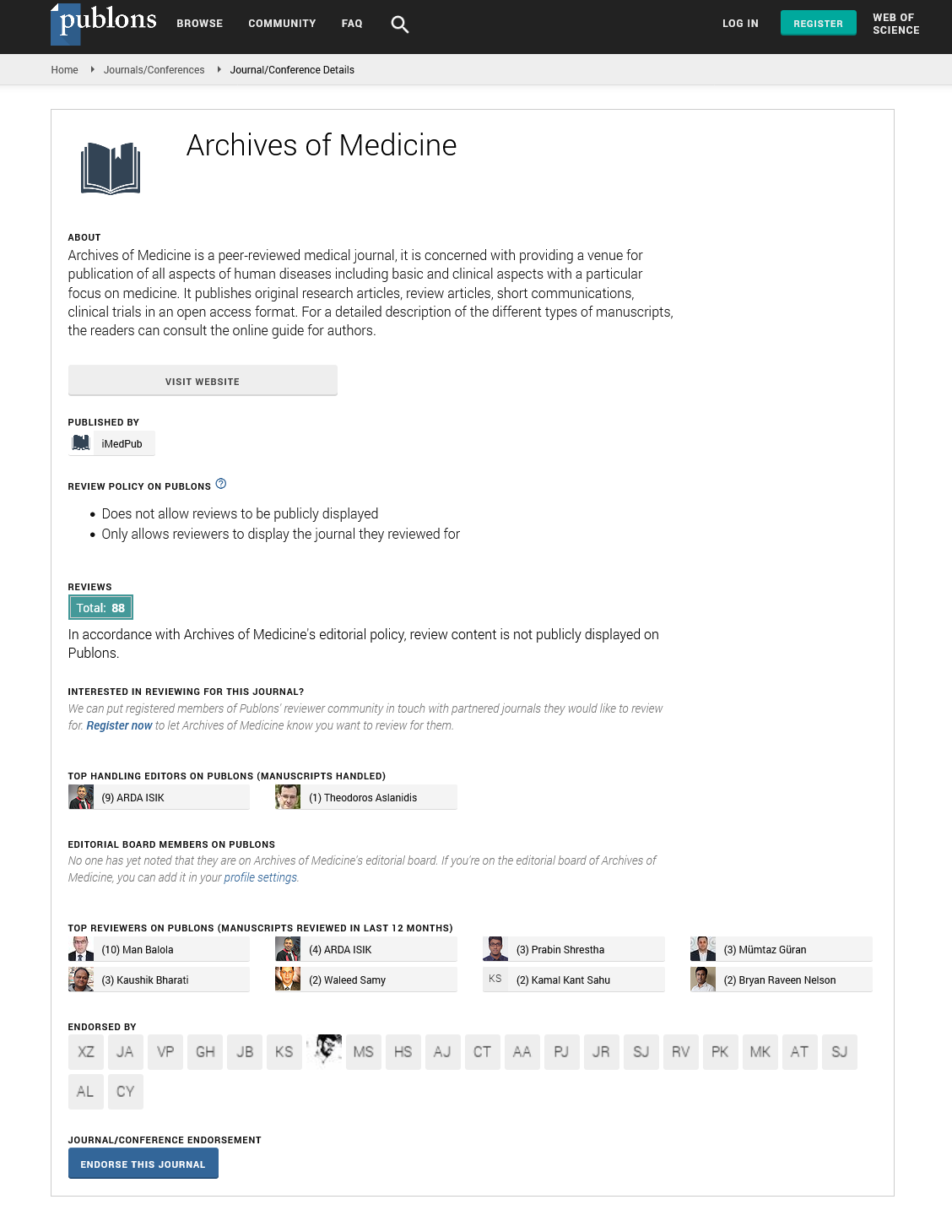Case Report - (2022) Volume 14, Issue 10
Clinical Manifestations of Simpson-Golabi-Behmel Syndrome
Ong Chee Seng*,
Muhd Hafifi Tulos and
Amaramalar Selvi Naicker
Department of Orthopaedics and Traumatology, University Kebangsaan Malaysia Medical Centre, Jalan Yaacob Latiff, Bandar Tun Razak, Kuala Lumpur, Malaysia
*Correspondence:
Ong Chee Seng, Department of Orthopaedics and Traumatology,
University Kebangsaan Malaysia Medical Centre, Jalan Yaacob Latiff, Bandar Tun Razak, Kuala Lumpur,
Malaysia,
Tel: 60124666045,
Email:
Received: 03-Mar-2022, Manuscript No. IPAOM-22-12573;
Editor assigned: 07-Mar-2022, Pre QC No. P-12573(PQ);
Reviewed: 22-Mar-2022, QC No. Q-12573;
Revised: 03-May-2022, Manuscript No. R-12573(R);
Published:
10-May-2022
Abstract
Simpson–Golabi–Behmel (SGB) syndrome is a rare X-linked condition characterized by pre and post natal overgrowth, facial malformations, visceral, skeletal anomalies and an increased risk of neonatal death and childhood neoplasia. The syndrome is caused by alterations in GPC3 gene with loss of functional GPC3 lead to hyperactivation of hedgehog signalling resulting in clinical features of fetal overgrowth. Prenatal screening and new technologies in molecular testing, such as chromosomal microarray analysis and nextgeneration sequencing, continually demonstrate advantages for definitive diagnosis in fetal life. However, SGB syndrome is rarely diagnosed in the prenatal setting. Here we reported a case of 12-year-old boy with a mild form type I SGB syndrome diagnosed postnatally in our centre.
Keywords
Fetal overgrowth; GPC3; Simpson-Golabi-Behmel syndrome; X-linked
INTRODUCTION
Simpson–Golabi–Behmel Syndrome (SGB) is a rare X-linked
recessive condition characterized by fetal overgrowth with broad
spectrum of its clinical manifestations, varying from very mild
forms associated with long-term survival to an early lethal form
with multiple congenital anomalies and severe mental retardation. It
was first described by Simpson, et al. in. Subsequently Golabi and
Rosen as well as Behmel, et al. had reported separate occasion on two
families with similar clinical condition in 1984 before it was coined as
SGB syndrome by Neri, et al. in year 1988. However, the prevalence of
SGB syndrome still remains unknown due to its early neonatal death
and uncertain clinical diagnosis at presentation [1].
Approximately 250 cases were published by Tenorio, et al. mostly in
postnatal series describing the typical congenital anomalies including
coarse facies, macroglossia and macrostomia, cardiac malformations,
skeletal anomalies, organomegaly and high birth weight. SGB
syndrome can be divided into type I which is the milder form, is caused
by a mutation in the gene for glypican-3 (GPC3) which maps to
Xq26 whereas type 2 is caused by a gene mutation on Xp22.
Recently, Capurro, et al. hypothesized that GPC3 acts as an
inhibitor of Hedgehog (Hh) signaling in the embryo. Loss of
functional GPC3 lead to hyperactivation of hedgehog signalling
resulting in fetal overgrowth found in the SGBS patients [2].
Interestingly, there are four cases of SGB syndrome involving females
so far reported in the literature represented extremely rare exceptions
to the X-linked recessive disorders model. An X-autosome
translocation, where the normal X is inactivated due to some
unknown reason. Here we presented a 12-year-old teenage boy with
various clinical manifestations of type I SGB syndrome which
diagnosis was made postnatal [3-6].
Case Presentation
The patient is the eldest son of two healthy non-consanguineous
parents. Gestation was uneventful until the 8th month, the
ultrasound showed polyhydramnios. However, no further
investigation was performed antenatally since that. He was born at
term via vacuum assisted delivery due to maternal poor effort. His
birth weight was 3.40 kg with features of dysmorphism including
coarse faces with wide mouth and protruding tongue, low set ears,
flat nasal bridge, micrognathia, broad fingers and toes and bilateral
undescended testis. Molecular karyotyping revealed normal male
genotype. Neonatal hypoglycemia was found and corrected. These
symptoms lead to suspect hypothyroidism for which tests were normal.
Subsequent ultrasound abdomen showed no abnormalities of
hepatobiliary system, but noted left renal pelvicalyceal dilatation.
However, further assessment by maturating cystourethrogram
revealed no vesicoureteric refluxes seen.
From birth the patient was followed up by a pediatrician for the
association of dimorphic features and bilateral undescended testis at
the regular intervals. Initially he was diagnosed as William syndrome but cytogenetic testing did not show visible deletion on ELN region
on chromosome 7. Several explorations were performed:
echocardiography did not reveal any congenital heart defect,
skeletal survey did not show any musculoskeletal abnormalities
such as vertebral fusion, scoliosis or congenital hip dislocation. A
mucopolysaccharide storage disorder was excluded by
appropriate tests in view of this metabolic disorder has similar
clinical feature of coarse facial appearance present on him.
The clinical features of SGB syndrome became prominent as
the patient grew up. He has those craniofacial manifestations
with coarse facial appearance including hypertelorism with low
set ears, flat and broad nose, macroglossia with presence of
central groove of the tongue, macrostomia with dental
malocclusion and flat occiput. Further clinical examination
revealed he has musculoskeletal manifestations of SGB syndrome
with presence of webbed neck, pectus excavatum with
supernumerary nipples. Hands and feet are relatively short and
broad, together with metatarsus virus or club foot deformities
and flat feet. Otherwise, there are no evidence of polydactyly polydactyly or syndactyly. These specific features increased index of
suspicious of SGB syndrome. Subsequent genetic study of GPC
3 gene was carried out at the age of three which confirmed the
diagnosis of SGB syndrome. The mother is a carrier of SGB
syndrome in the family. Since SGB syndrome is X-linked
recessive disease, further exploration on family history on
maternal side revealed there are two male siblings of patient’s
mother have early neonatal death in 1970’s. However, the cause
of death was not documented at that time.
Serial ultrasound of kidney was done to monitor the dilated left
kidney during follow-up showed no progression of disease. The
right testis eventually descended spontaneously. However, the left
testis required an orchidopexy which was done at the age of three.
He required a tenotomy to his bilateral tight archilles tendon to
correct an ankle equinovarus deformity at the age of ten for him to
be able to walk with feet in plant grade position and active in sport
in school. He has normal intelligent (Fig. 1).

Fig. 1. The patient at 12 years
old. a) Presence of “coarse” face;
b) Presence of midline groove of
the tongue.
Results and Discussion
SGB syndrome is a well-established entity within the larger
family of overgrowth syndromes due to the specificity of the
clinical presentation. Those nearly constant clinical features
include microsomal, macrocephaly with “coarse” faces,
supernumerary nipples, pectus excavatum and muscular
hypotonia. Besides that, it also has common wide spectrum
clinical manifestations such as macrostomia, macroglossia with
dental malocclusion, congenital heart defect, organomegaly,
cryptorchidism, umbilical or inguinal hernia, rib or vertebral
abnormalities as well as hands and feet deformities. Cardiac
abnormalities are common in SGB syndrome, occurring in
almost one half of cases with cardiovascular malformations
evident in one third of cases. Early perinatal and infant mortality is very likely from cardiac abnormalities. Our patient does not
have congenital heart defect since birth, which explains the long
term survival in this spectrum of syndrome.
It has been proposed that polyhydramnios with prenatal
overgrowth and elevated maternal plasma alpha-fetoprotein
may be prenatal markers of SGB syndrome. Fetal microsomal
and polyhydramnios was detected in 86% and 70% of cases
respectively. Cottereau, et al. reported a high proportion of one
third preterm deliveries in SGB syndrome babies were likely due
to an excessive amniotic fluid. These can be a screening tool for
those with related presentation antenatally. However, these
investigation findings are non-specific, need further evaluation
sampling from amniocentesis with targeted sequencing for the
GPC3 variant (Fig. 2).

Fig. 2. a) Presence of broad big toes
with metatarsus virus and flat feet;
b) Well-healed post tenotomise scar of
bilateral Achilles tendons.
Ultrasound scan is an effective tool to detect prenatal fetal
congenital anomalies. Affected fetus may present with
distinctive features of SGB syndrome on ultrasound. Enlarged
nuchal translucency in ultrasound scan is a well-known marker of
chromosomal anomalies present in cases of chromosomal
pathologies, cardiac anomalies and certain genetic syndromes
including Noonan syndrome and SGB syndrome. However, it is
difficult to determine the estimated incidence of increased nuchal
translucency as a marker of SGB syndrome because no data on the
first trimester scan are available in most of the cases. Therefore,
careful ultrasound examination followed by chromosomal
microarray analysis and Whole-Exome Sequencing (WES) are
effective tools for prenatal diagnosis of SGB syndrome. We
postulated the cause of death of the mother’s siblings is likely due
to severe form of SGB syndrome that carry in the family.
Terespolsky, et al. reported a family of four maternally related
male cousins with a severe variant of SGB overgrowth
syndrome died within the first 8 weeks of life of multiple
complications (Fig. 3).

Fig. 3. Presence of webbed neck and pectus
excavatum with supernumerary nipples.
The main overlap in clinical presentation for SGB syndrome would
be with Beckwith-Wiedemann Syndrome (BWS), in which both
of them share the major diagnostic features. However, several
clues can guide the correct diagnosis. SGB syndrome patients
appear more dimorphic with musculoskeletal abnormalities and
nipple abnormalities. They generally do not have abdominal wall
defects such as omphalocele as opposed to BWS. Another clue is
that the degree of dysmorphism increases with age in SGB
syndrome, while the opposite is true for BWS patients. Since
SGB is X-linked, the majority of affected individuals are males,
with females presenting with milder symptoms. BWS is unlikely
to present skeletal and cardiac anomalies except cardiomegaly as
opposed to SGB syndrome. Midline capillary hemangiomas, body
asymmetries with hemi hypertrophy, and tendency to decelerated
growth can be considered as findings more typical of WBS.
Therefore, in suspicious cases of fetal overgrowth with congenital
anomalies, genomic investigations should include BWS testing
despite GPC3 gene sequencing.
There is an increased risk of neoplasia in SGBS especially in young
patients. A Wilms tumor of the kidney was reported in few cases of
SGB syndrome patients. All of these cases were diagnosed before age
two years old. Since our patient has a left pelvicalyceal dilatation of
the kidney, he is on regular ultrasound surveillance yearly with so
far no progression of dilatation or abnormal growth. Although by now
his risk of neoplasia is probably approaching that of the general
population, however there is lack of long term data to support it.
Therefore, we recommended every SGB overgrowth syndrome
patient should be considered at increased risk, and consequently
follow-up for the development of Wilms or other known infantile
tumours for at least the first five years of life. On the other hand,
Gurrieri, et al. reported a case whereby the SGB syndrome patient’s
mother had ovarian cancer at 22 years and a maternal great-aunt
had breast cancer at 46 years. It shows the tumour may be related to
the carrier status. Therefore, every SGBS family be checked for the
presence of tumours in the affected males as well as the carrier females. However, long term evidence is still need to establish
the risk of neoplasia in adulthood in SGB syndrome patients as
well as carriers.
Conclusion
SGB syndrome is a rare X-linked recessive condition with
well specificity of the clinical presentation but often diagnosed
postnatally. The role of detailed ultrasound examination is crucial
in cases of highly suspected genetic syndromes in prenatal life.
Modern sequencing technologies often facilitate the diagnosis of
the SGB syndrome, help to differentiate other overgrowth
syndromes. A better understanding of the pathophysiology of
excessive growth during development, together with some
aspects of neoplastic growth in the hope of more SGB syndrome
cases can be better managed.
REFERENCES
- Brioude F, Kalish JM, Mussa A, et al. Expert consensus document: Clinical and molecular diagnosis, screening and management of Beckwith-Wiedemann syndrome: an international consensus statement. Nat Rev Endocrinol. 2018;14:229-249.
[Crossref][Googlescholar][Indexed]
- Cottereau E, Mortemousque I, Moizard MP, et al. Phenotypic spectrum of Simpson-Golabi-Behmel syndrome in a series of 42 cases with a mutation in GPC3 and review of the literature. Am J Med Genet C Semin Med Genet. 2013;163:92-105.
[Crossref][Googlescholar][Indexed]
- Gurrieri F, Pomponi MG, Pietrobono R, et al. The Simpson–Golabi–Behmel Syndrome: A Clinical Case and a Detective Story. Am J Med Genet Part A. 2011;155:145-148.
[Crossref][Googlescholar][Indexed]
- Konstantin R, Elvira K, Sander P, et al. Two Consecutive Pregnancies with Simpson-Golabi-Behmel Syndrome Type 1: Case Report and Review of Published Prenatal Cases. Mol Syndromol. 2018;9:205-213.
[Crossref][Googlescholar][Indexed]
- Terespolsky D, Farrell SA, Siegel-Bartelt J, et al. Infantile lethal variant of Simpson-Golabi-Behmel syndrome associated with hydrops fetalis. Am J Med Genet. 1995;59:329-33.
[Crossref][Googlescholar][Indexed]
- Tenorio J, Arias P, Martínez-Glez V, et al. Simpson-Golabi- Behmel syndrome types I and II. Orphanet J Rare Dis. 2014;9:138.
[Crossref][Googlescholar][Indexed]









